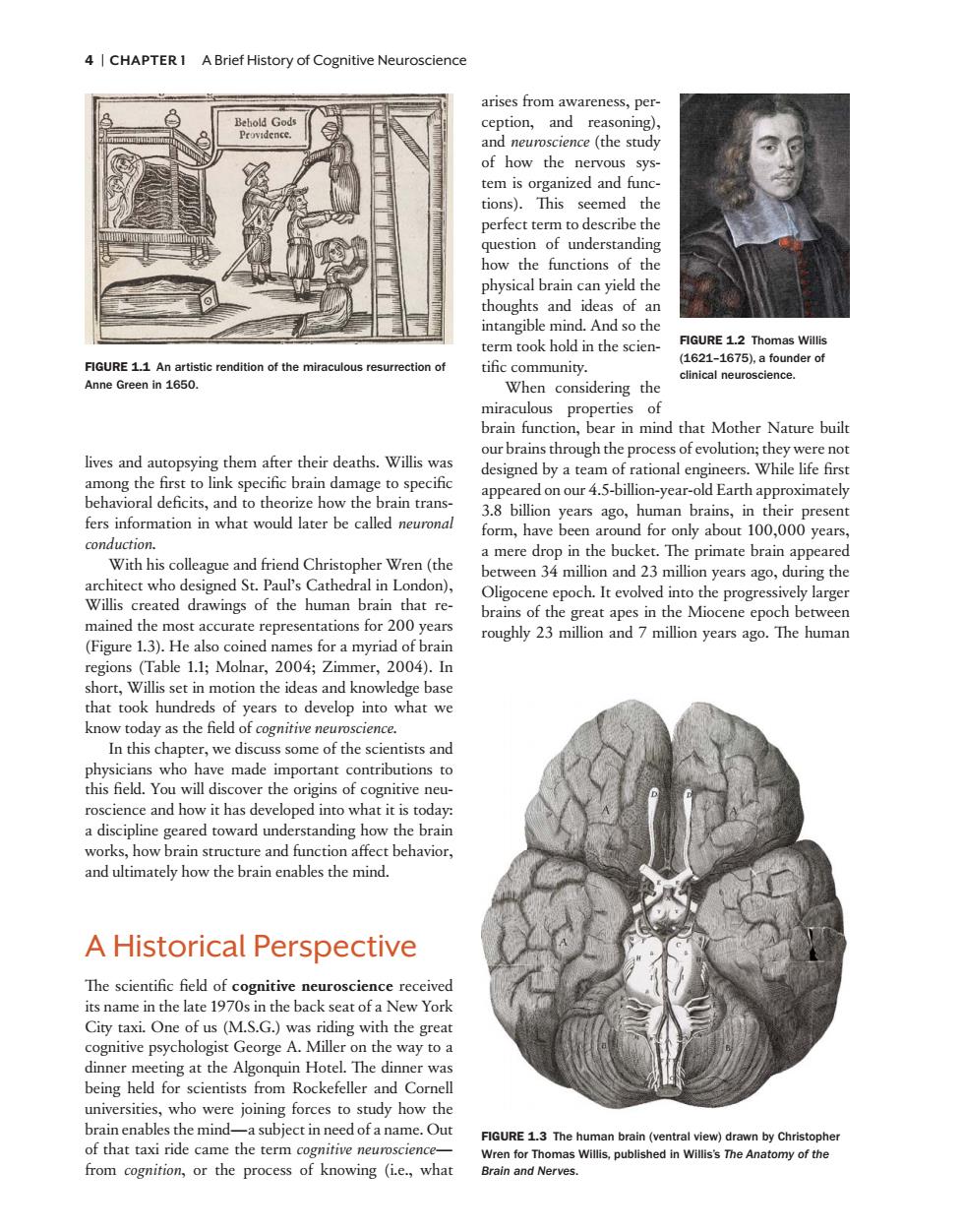正在加载图片...

4|CHAPTER 1 A Brief History of Cognitive Neuroscience arises from awareness,per eption, and reasoning) (the stud sys and ideas of an mind.And so the erm took hold in the scien- AGURE 1.1 An artistic rendition of the mira tific community. Anne Green in 1650. When considering the cinical neuroscience. ue Mler Narea our brains through the process of evolution;they were not to link specific brain da designed by a team of rational engineers.While life first appeared on our 4.5-billion-year-old Earth approximately fers information in what would later be called neuronal 3.8 billion years ago,human brains,in their present form,have been around for only about 100,000 years conduction With his colleague and friend Christopher Wren(the a mere drop in the bucket.The primate brain appeared architect who designed St.Paul's Cathedral in London), etween 34 million and 23 million years ago,during the Willis created drawings of the human brain that re- Dligocene epoch.It evolved into the progressively larger mained the most accurate representations for 200 years (Figure 1.3).He also coined names for a myriad of brain regions (Table 1.1;Molnar,2004;Zimmer,2004).In short,Willis set in motion the ideas and knowledge base that took er.we some o and mad ions to r the e and h red tov ard und A Historical Perspective City taxi.One of us(M.S.G.)was riding with the g 23 cognitive psychologist George A.Miller on the way to a dinner meeting at the Algonquin Hotel.The dinner was being held for scientists from Rockefeller and Cornell universities,who were joining forces to study how the brain enables the mind-a subject in need of a name.Out of that taxi ride came the term cognitive neuroscience- from cognition,or the process of knowing (i.e.,what Brain and Nerves.4 | CHAPTER 1 A Brief History of Cognitive Neuroscience arises fr om awareness, perception, and reasoning), and neuroscience (the study of how the nervous system is organized and functions). Th is see med the perfect term to describe the question of understanding how the functions of the physical brain can yield the thoughts and ideas of an intangible mind. And so the term took hold in the scientifi c community . When considering the miraculous properties of brain function, bear in mind that Mother Nature built our brains through the process of evolution; they were not designed by a team of rational enginee rs. While life fi rst appeared on our 4.5-billion-year-old Earth approximately 3.8 billion years ago, human brains, in their present form, have bee n around for only about 100,000 years, a mere drop in the bucket. Th e primate brain appeared betw ee n 34 million and 23 million years ago, during the Oligocene epoch. It evolved into the progressively larger brains of the great apes in the Miocene epoch betw ee n roughly 23 million and 7 million years ago. Th e human lives and autopsying them aft er their deaths. Willis was among the fi rst to link specifi c brain damage to specifi c behavioral defi cits, and to theorize how the brain transfers information in what would later be called neuronal conduction . With his colleague and fr iend Christopher Wren (the architect who designed St. Paul’s Cathedral in London), Willis created drawings of the human brain that remained the most accurate representations for 200 years (Figure 1.3). He also coined names for a myriad of brain regions (Table 1.1; Molnar, 2004; Zimmer, 2004). In short, Willis set in motion the ideas and knowledge base that took hundreds of years to develop into what we know today as the fi eld of cognitive neuroscience . In this chapter, we discuss some of the scientists and physicians who have made important contributions to this fi eld. You will discover the origins of cognitive neuroscience and how it has developed into what it is today: a discipline geared toward understanding how the brain works, how brain structure and function aff ect behavior, and ultimately how the brain enables the mind. A Historical Perspective Th e scientifi c fi eld of cognitive neuroscience received its name in the late 1970s in the back seat of a New York City taxi. One of us (M.S.G.) was riding with the great cognitive psychologist George A. Miller on the way to a dinner mee ting at the Algonquin Hotel. Th e dinner was being held for scientists fr om Rockefeller and Cornell universities, who were joining forces to study how the brain enables the mind—a subject in nee d of a name. Out of that taxi ride came the term cognitive neuroscience — fr om cognition , or the process of knowing (i.e., what FIGURE 1.1 An artistic rendition of the miraculous resurrection of Anne Green in 1650. FIGURE 1.3 The human brain (ventral view) drawn by Christopher Wren for Thomas Willis, published in Willis’s The Anatomy of the Brain and Nerves. FIGURE 1.2 Thomas Willis (1621–1675), a founder of clinical neuroscience. 002_021_CogNeu_4e_Ch01.indd 4 7/17/13 9:27 AM